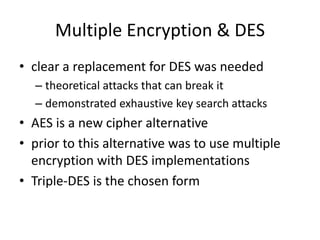Report
Share

Recommended
Recommended
More Related Content
Similar to 41.ppt
Similar to 41.ppt (20)
Information and data security block cipher and the data encryption standard (...

Information and data security block cipher and the data encryption standard (...
Information and data security block cipher operation

Information and data security block cipher operation
More from TapodhirAcharjee2
Recently uploaded
God is a creative God Gen 1:1. All that He created was “good”, could also be translated “beautiful”. God created man in His own image Gen 1:27. Maths helps us discover the beauty that God has created in His world and, in turn, create beautiful designs to serve and enrich the lives of others.
Explore beautiful and ugly buildings. Mathematics helps us create beautiful d...

Explore beautiful and ugly buildings. Mathematics helps us create beautiful d...christianmathematics
APM Welcome
Tuesday 30 April 2024
APM North West Network Conference, Synergies Across Sectors
Presented by:
Professor Adam Boddison OBE, Chief Executive Officer, APM
Conference overview:
https://www.apm.org.uk/community/apm-north-west-branch-conference/
Content description:
APM welcome from CEO
The main conference objective was to promote the Project Management profession with interaction between project practitioners, APM Corporate members, current project management students, academia and all who have an interest in projects.APM Welcome, APM North West Network Conference, Synergies Across Sectors

APM Welcome, APM North West Network Conference, Synergies Across SectorsAssociation for Project Management
Recently uploaded (20)
Basic Civil Engineering first year Notes- Chapter 4 Building.pptx

Basic Civil Engineering first year Notes- Chapter 4 Building.pptx
Web & Social Media Analytics Previous Year Question Paper.pdf

Web & Social Media Analytics Previous Year Question Paper.pdf
Measures of Central Tendency: Mean, Median and Mode

Measures of Central Tendency: Mean, Median and Mode
Measures of Dispersion and Variability: Range, QD, AD and SD

Measures of Dispersion and Variability: Range, QD, AD and SD
Explore beautiful and ugly buildings. Mathematics helps us create beautiful d...

Explore beautiful and ugly buildings. Mathematics helps us create beautiful d...
APM Welcome, APM North West Network Conference, Synergies Across Sectors

APM Welcome, APM North West Network Conference, Synergies Across Sectors
41.ppt
- 1. Multiple Encryption & DES • clear a replacement for DES was needed – theoretical attacks that can break it – demonstrated exhaustive key search attacks • AES is a new cipher alternative • prior to this alternative was to use multiple encryption with DES implementations • Triple-DES is the chosen form
- 2. Double-DES? • could use 2 DES encrypts on each block – C = EK2(EK1(P)) • issue of reduction to single stage • and have “meet-in-the-middle” attack – works whenever use a cipher twice – since X = EK1(P) = DK2(C) – attack by encrypting P with all keys and store – then decrypt C with keys and match X value – can show takes O(256) steps
- 3. Meet In the Middle Attack • For the double-DES cipher & a given (P,C) pair, this attack works as follow: • Encrypt the plaintext P with all possibilities of Ka, store the results in a table, & sort that table by the value of 2length(ka). • Decrypt C with all possible values of Kb, check each resulted value with the entries in the table, in case of match, check these two keys against another known pair (P1,C1), if match, accept them as the correct keys.
- 4. Triple-DES with Two-Keys • hence must use 3 encryptions – would seem to need 3 distinct keys • but can use 2 keys with E-D-E sequence – C = EK1(DK2(EK1(P))) – nb encrypt & decrypt equivalent in security – if K1=K2 then can work with single DES • standardized in ANSI X9.17 & ISO8732 • no current known practical attacks – several proposed impractical attacks might become basis of future attacks
- 5. Triple-DES with Three-Keys • although are no practical attacks on two-key Triple-DES have some indications • can use Triple-DES with Three-Keys to avoid even these – C = EK3(DK2(EK1(P))) • has been adopted by some Internet applications, eg PGP, S/MIME
- 6. Modes of Operation • block ciphers encrypt fixed size blocks – eg. DES encrypts 64-bit blocks with 56-bit key • need some way to en/decrypt arbitrary amounts of data in practise • NIST SP 800-38A defines 5 modes • have block and stream modes • to cover a wide variety of applications • can be used with any block cipher
- 7. Electronic Codebook Book (ECB) • message is broken into independent blocks which are encrypted • each block is a value which is substituted, like a codebook, hence name • each block is encoded independently of the other blocks Ci = EK(Pi) • uses: secure transmission of single values
- 9. Advantages and Limitations of ECB message repetitions may show in ciphertext if aligned with message block particularly with data such graphics or with messages that change very little, which become a code-book analysis problem weakness is due to the encrypted message blocks being independent main use is sending a few blocks of data
- 10. Cipher Block Chaining (CBC) • message is broken into blocks • linked together in encryption operation • each previous cipher blocks is chained with current plaintext block, hence name • use Initial Vector (IV) to start process Ci = EK(Pi XOR Ci-1) C-1 = IV • uses: bulk data encryption, authentication